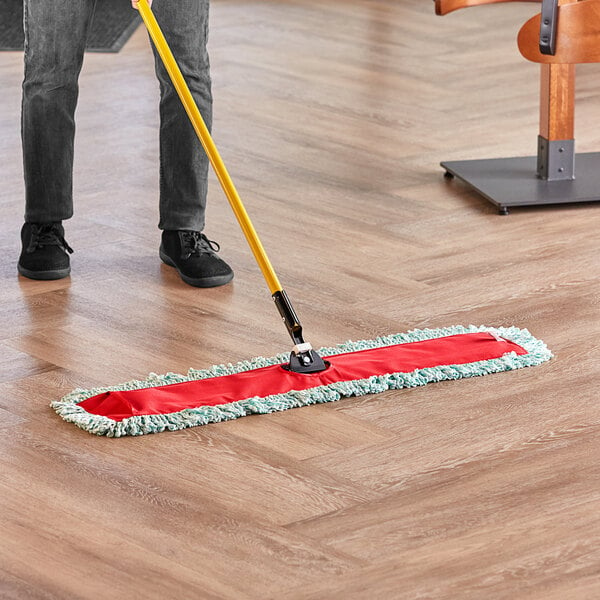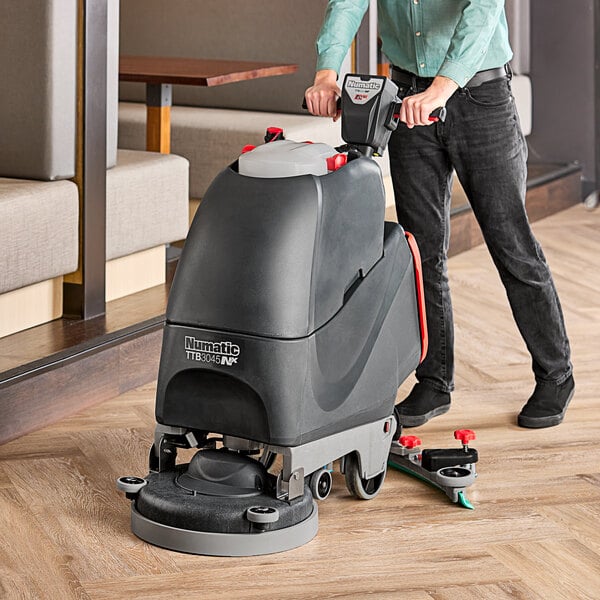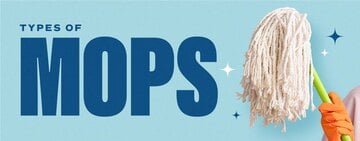
Cleaning commercial floors is crucial for maintaining a safe, professional, and inviting environment. The correct cleaning methods, tools, and frequency ensure floors last longer, look better, and remain safe for staff and customers. Whether your floor is tile, vinyl, hardwood, or concrete, understanding the specific care each surface requires will help you keep your floors in top condition. This guide provides practical steps and tips for properly cleaning and maintaining commercial floors in any setting.
Shop All Commercial Floor Care SuppliesBest Way to Clean Floors
Regular floor maintenance is key to ensuring the longevity and appearance of your commercial floors. Establish a routine for sweeping, vacuuming, and mopping to prevent dirt and debris buildup, which can cause scratches and stains. Use the right cleaners for each type of flooring, as harsh chemicals can damage surfaces over time. For high-traffic areas, consider placing mats to reduce wear and tear. Apply wax or floor finish as needed to protect surfaces from scuffs, moisture, and dirt. Finally, inspect floors regularly for damage or unevenness and address issues promptly to avoid more extensive repairs later.
How to Clean Hardwood Floors

Hardwood floors add a warm, polished look to commercial spaces but require special care to maintain their durability and shine. You’ll often find them in upscale restaurants, hotels, and office spaces where aesthetics matter. Unlike tile or concrete, hardwood is sensitive to moisture and harsh chemicals, so proper cleaning techniques prevent damage and extend its lifespan. Follow these steps to keep hardwood floors looking their best.
- Sweep or Dry Mop: Remove dirt, dust, and debris daily with a broom or microfiber dust mop to prevent scratches.
- Use a pH-neutral Cleaner: Apply a commercial hardwood floor cleaner with a damp mop to clean without harming the wood finish.
- Avoid Excess Water: Never soak hardwood floors; use a damp mop and immediately dry the surface with a clean cloth.
- Buff for Shine: Use a dry microfiber mop or floor buffer to restore shine without leaving residue.
- Apply Wood Floor Polish: For added protection, apply a commercial wood floor polish according to manufacturer instructions.
Tips for Cleaning Hardwood Floors
To protect hardwood floors, always clean spills immediately to prevent warping or staining. Avoid using excessive water, steam mops, or harsh chemicals, as these can damage the wood’s finish. Place rugs or floor mats in high-traffic areas to minimize wear and reduce dirt buildup. Regular maintenance, including buffing and occasional polishing, keeps commercial hardwood floors looking clean and professional.
How to Clean Laminate Floors

Laminate flooring is a cost-effective, durable option found in cafes, quick-service restaurants, and break rooms. While it mimics the look of hardwood, laminate is more resistant to moisture and stains but can still be damaged by excessive water and harsh chemicals. Regular cleaning prevents dirt buildup, maintains its shine, and extends its lifespan. Follow these steps to clean laminate flooring in commercial settings properly.
- Sweep or Vacuum: Remove dust, dirt, and debris daily to prevent scratches.
- Use a Damp Mop: Lightly dampen a microfiber mop with a laminate-safe cleaner to remove stains and grime.
- Avoid Excess Water: Standing water can seep into seams and cause warping, so always use minimal moisture.
- Buff for Shine: Dry the floor immediately with a soft cloth or dry mop to prevent streaking.
- Spot Clean Stubborn Stains: Use a non-abrasive sponge and laminate-safe cleaner to remove tough spots without damaging the surface.
Laminate vs Vinyl Flooring
Laminate and vinyl flooring are both popular in commercial foodservice settings, but they have different moisture resistance. Laminate is made from compressed wood with a protective top layer, giving it a realistic wood-like appearance, but it is more sensitive to moisture. Vinyl, made from synthetic materials, is fully waterproof and more resistant to spills, making it ideal for high-moisture areas. While both options are durable and easy to maintain, vinyl is better suited for kitchens and heavy-use environments, while laminate works well in dining and customer-facing spaces.
Tips for Cleaning Laminate Floors
To protect laminate flooring, avoid using abrasive scrubbers, steam cleaners, or wax-based products, as they can damage the surface. Always use a damp mop rather than a soaking wet one to prevent moisture from seeping into the seams. Put mats in high-traffic areas to reduce wear and trap dirt before it reaches the floor. Regular sweeping and immediate spill cleanup will keep laminate floors looking clean and professional.
How to Clean Tile Floors

Tile flooring is a durable and water-resistant option commonly found in restaurant kitchens, restrooms, and dining areas. While tiles are easy to clean, grout lines can trap dirt and bacteria, requiring extra attention. Using the right cleaning methods prevents buildup, maintains slip resistance, and keeps floors looking professional. Follow these steps to properly clean commercial tile floors.
- Sweep or Vacuum: Remove dirt, dust, and food debris daily to prevent buildup.
- Mop with a Neutral Cleaner: Use a pH-neutral tile cleaner and a damp mop to lift grease and stains without damaging the surface.
- Scrub Heavily Soiled Areas: For stubborn grime, use a deck brush or scrubber to loosen dirt from textured tiles.
- Rinse Thoroughly: Mop with clean water to remove any leftover cleaning solution and prevent residue buildup.
- Dry the Floor: Use a dry mop or towel to absorb excess moisture and reduce the risk of slips.
How to Clean Grout on Tile Floor
Grout lines between tiles can collect dirt, grease, and bacteria, making them harder to clean than the tiles themselves. Regular grout maintenance prevents staining and helps maintain a sanitary workspace. Follow these steps to effectively clean tile grout without damaging the floor.
- Remove surface debris by sweeping and mopping to clean the tiles before focusing on the grout.
- Use a commercial grout cleaner or a mixture of baking soda and water to break down stains.
- Gently scrub grout lines with a soft-bristle brush or grout brush to remove embedded dirt.
- Wipe away the cleaner with a damp mop or cloth to prevent residue buildup.
- Apply a grout sealer to create a protective barrier against future stains and moisture absorption.
Tips for Cleaning Tile Floors
Avoid harsh acidic cleaners, as they can erode grout and dull tile finishes. Clean spills immediately to prevent staining and reduce slip hazards. Use a degreaser in kitchens to remove oily residue that can make floors slick. Regular deep cleaning, combined with daily maintenance, will keep commercial tile floors looking clean and professional.
How to Clean Vinyl Floors

Vinyl flooring is a durable, water-resistant option commonly found in commercial kitchens, dining areas, and restrooms. It requires regular cleaning to prevent dirt buildup, maintain its appearance, and reduce slip hazards. Unlike hardwood or laminate, vinyl can handle more moisture, but harsh chemicals and abrasive tools should be avoided to prevent damage. Follow these steps to keep vinyl floors clean and in top condition.
- Sweep or Vacuum: Remove dust, dirt, and debris daily to prevent scratching and buildup.
- Mop with a Neutral Cleaner: Use a pH-neutral vinyl floor cleaner and a damp mop to lift stains and grease.
- Scrub Stubborn Stains: For tough spots, use a soft-bristle brush or non-abrasive scrub pad with a vinyl-safe cleaner.
- Rinse with Clean Water: Mop with fresh water to remove any leftover cleaning solution and prevent residue.
- Dry the Floor: Use a dry mop or towel to absorb excess moisture and prevent slips.
Tips for Cleaning Vinyl Floors
Avoid using steam cleaners or excessive water, as moisture can seep into seams and weaken the adhesive. Put mats in high-traffic areas to minimize dirt and wear. Use felt protectors under furniture legs to prevent scuffs and dents. Regular cleaning and proper care will extend the lifespan of commercial vinyl flooring.
How to Clean Concrete Floors

Concrete floors are a durable and low-maintenance option commonly found in warehouses, commercial kitchens, and industrial spaces. Although resistant to heavy traffic and moisture, they can stain easily and require regular cleaning to prevent grime buildup. Sealed concrete is easier to maintain, while unsealed surfaces need extra care to avoid absorbing spills. Follow these steps to keep concrete floors clean and well-maintained.
- Sweep or Vacuum: Remove dust, dirt, and debris daily to prevent buildup and surface scratches.
- Mop with a pH-neutral Cleaner: Use a mild, pH-neutral cleaner and warm water to lift dirt without damaging the concrete.
- Scrub Tough Stains: For oil or grease stains, use a degreaser and a stiff-bristle brush to break down residue.
- Rinse with Clean Water: Mop with fresh water to remove any remaining cleaner and prevent streaking.
- Allow to Air Dry: Ensure the floor is completely dry before allowing foot traffic to prevent slips. Use safety signs to designate where floors are slippery.
Tips for Cleaning Concrete Floors
Use a sealant to protect concrete floors from moisture, stains, and wear. Avoid harsh acidic cleaners, as they can erode the surface over time. Add mats at entry points to minimize dirt tracking and reduce maintenance. Regular sweeping and occasional deep cleaning will keep concrete floors looking professional and prolong their lifespan.
How to Strip a Floor

Stripping a floor removes old wax, built-up dirt, and embedded grime, restoring the surface for resealing and refinishing. This process is essential for maintaining the appearance and durability of vinyl, linoleum, and other sealed commercial flooring. Floors should be stripped when they become dull, discolored, or difficult to clean despite regular maintenance. Follow these steps to strip a floor properly and prepare it for refinishing.
- Prepare the Area: Remove furniture, signage, and any obstacles to create a clear workspace. Put on protective clothing and ensure the room is properly ventilated.
- Sweep or Vacuum: Clear the floor of dust, dirt, and debris to prevent interference with the stripping solution.
- Apply Floor Stripper: Use a mop or sprayer to evenly distribute a commercial floor stripping solution one small section at a time, following the manufacturer’s dilution instructions. Use a type recommended by your floor's manufacturer to ensure it doesn't damage your flooring.
- Let the Solution Sit: Allow the stripper to break down the old wax for the recommended time, usually 10-15 minutes.
- Scrub the Floor: Use a floor scrubbing machine with a stripping pad or a scrub brush to lift the old finish and remaining residue. For hard-to-reach areas, try using a type of floor scraper or brush.
- Remove the Debris: Mop up the loosened wax and dirt with a wet vacuum or absorbent mop.
- Rinse Thoroughly: Wash the floor with clean water to remove all stripping solution and residue.
- Allow to Dry Completely: Ensure the floor is fully dry before applying a new seal or finish.
How to Wax a Floor

Waxing is essential for maintaining vinyl, linoleum, and other sealed commercial floors by creating a protective layer that enhances shine and prevents wear. Regular waxing helps floors resist scuffs, stains, and moisture damage, making daily cleaning easier. Floors should be waxed when they start looking dull or when previous wax layers wear down due to heavy foot traffic.
- Read the Wax Instructions: Follow the manufacturer’s guidelines for application, drying times, and recommended layers.
- Use a Clean Mop Head: A brand-new mop head prevents dirt and debris from contaminating the wax.
- Ensure Proper Airflow: Open doors or use fans to ventilate the area and minimize exposure to fumes.
- Prepare the Wax Bucket: Line a bucket with a disposable trash can liner, then fill it with wax for easy cleanup.
- Apply a Thin Coat of Wax: Dip the mop into the wax, wring out excess, and apply a smooth, even layer while working toward the exit.
- Allow the Wax to Dry: Wait until the wax is completely dry before applying additional layers, as humidity and temperature affect drying time.
- Apply Multiple Layers if Needed: Most floors require 2 to 5 coats of wax, ensuring each layer dries fully before adding the next.
- Buff and Polish: Use a floor machine to buff the waxed surface, creating a high-gloss, durable finish.
Regular floor cleaning and maintenance protect your investment and enhance the appearance of your commercial space. By following the right procedures and using the proper tools, you can extend the life of your floors and keep them looking clean and professional. Consistency and attention to detail in your floor care routine will reduce the need for costly repairs and ensure a safe, welcoming environment for everyone.





